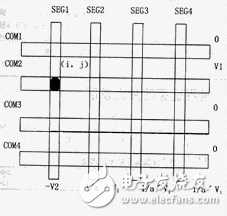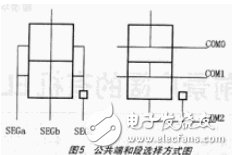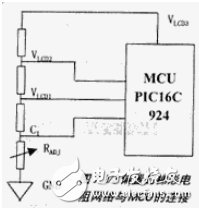The driving methods of the liquid crystal display include a static driving method, a dynamic driving method, and a dual frequency driving method. This article only explains the most widely used dynamic drive method. Taking the dot-matrix liquid crystal display as an example, the dynamic driving method is introduced, and a way to overcome the cross effect is given.
The display of the liquid crystal is due to the application of an electric field on the display pixels, which is the synthesis of the potential signals on the two electrodes before and after the display pixels. Since the DC electric field tends to lower the life of the liquid crystal, generally only an AC electric field having a very small DC component is established. The DC component is usually less than 50 mV. The driving of the liquid crystal display establishes a driving electric field by adjusting the phase, peak, frequency, and the like of the potential signal applied to the electrodes of the liquid crystal display to realize display.
Dynamic drive method
When the liquid crystal display displays a large number of pixels, such as a dot matrix type, in order to save a huge hardware driving circuit, the fabrication and arrangement of the liquid crystal display electrodes are processed, and a matrix structure is implemented: that is, the back electrodes of a horizontal set of display pixels are connected. They are taken together and referred to as row electrodes; the segment electrodes of the longitudinal display pixels are connected together and referred to as column electrodes. Each pixel on the display is uniquely identified by its rank and rank. The dynamic driving method of the liquid crystal display is to cyclically apply a selection pulse to the row electrodes, and simultaneously add a response selection or a non-selection drive pulse to all the column electrodes, thereby realizing the display function of all pixels in a certain row. This scanning is performed in a row-by-row sequence with a short cycle period, resulting in a stable image on the LCD screen.
The selection time of each line in one frame is equal. Assuming that the number of scanning lines of one frame is N and the scanning time is 1, then the selection time of one line is 1/N of one frame time. This is the duty ratio coefficient of the liquid crystal display driver, also called the duty ratio.
Overcome cross effects
In the dynamic driving mode, to make a position such as (i, j) point display, it is necessary to simultaneously apply a selection voltage on the i-th column and the j-th row to maximize the variable electric field strength at the point, but at this time Outside the (i, j) point, the remaining points of the i-th column and the j-th row are also subjected to a certain voltage, and these points are called semi-selected points. If the effective voltage at the semi-selected point is greater than the threshold voltage, an undue display will appear on the screen, causing the contrast to drop, which is the cross effect. The solution to the cross-effect is the average voltage method, which averages the voltages of the semi-selected points and the non-selected points, moderately increases the voltage of the non-selected points to offset a part of the voltage at the semi-selected point, and causes the voltage at the semi-selected point to drop, thereby Increase display contrast. Now illustrated in Figure 1:

The selection point in Fig. 1 is (SEG1, COM2), hereinafter referred to as (1, 2). Now the second line applies the V1 voltage, and the remaining lines are 0V; the first column applies the -V2 voltage, and the rest are non-selected voltages 1/a'V1. Next, the potential difference at each point is analyzed, that is, the line voltage minus the column voltage.
Select point: (1, 2): V1 + V2
Semi-selection points: (1,1), (1,3), (1,4): V2(2,2), (3,2), (4,2);V1-1/a'V1
Non-selection point: -1/a'V1
In order to ensure the display effect of the selected point, V1+V2=VLCD is maintained at the required voltage value VLCD. At the same time, in order to improve the contrast of the display, let |V2|=|-1/a'V1|, namely:
![]()
Solution:
![]()
Order: a'+1=a, get:
![]()
Thus, the voltage at each point in Figure 1 is:
Select point: (1, 2): VLCD
Semi-selection points: (1,1), (1,3), (1,4): (1/a)VLCD(2,2),(3,2),(4,2):[(a- 2) / a] VLCD
Non-selection point: -(1/a)VLCD
It can be seen that the voltages on the row half selection point and the non-selection point are 1/a of the display voltage VLCD. This 1/a is called the bias voltage coefficient, also called the bias voltage. This method is called the average voltage method of 1/a bias, and is abbreviated as 1/a bias method. In this method, MAX{[(A-2)/a]VLCD, (1/a)VLCD} will be the measure to adjust the display contrast. When the number of scanning lines N=1, the dynamic driving method is equal to the static driving method.
Application examples of dynamic driving method
In the process of selecting the display mode of the alcohol concentration detector, the author selected the VM807-2 8-bit code segment type (7-segment) liquid crystal display produced by Hong Kong Jingdian Company through multi-party investigation and investigation. In addition to the fact that the liquid crystal display consumes a small amount of electrodes, and because the MCU (PIC16C924) we use already has the driving capability of the LCD, this choice is undoubtedly reasonable regardless of cost reduction or simplified circuit considerations. of. Below we will explain the specific application of the LCD module in the MCU.
LCD module configuration
1, the configuration of the LCDCON register
The LCDCON register is shown in Figure 2:

Among them: LCDEN: LCD module enable; SLPEN: sleep mode enable; VGEN: internal voltage generation enable; CS1: CS0: LCD clock select bit, "00" = Fosc / 256, Fosc = 4MHz; LMUX1: LUMX2: public Number of terminals and offset selection, "10" = 3 common, 1/3 offset.
The configuration code I used is.
Configuration of the LCDPS register
The LCDPS register is shown in Figure 3:

Where: LP3: LP0 frame clock frequency division selection bit
The configuration code I used is: ***0011, where "*" stands for "0" or "1".
According to the frame frequency calculation formula, the frame frequency is:
CLOCk source/96 (LP3: LP1+1)
=4&TImes;106/96&TImes;(3+1)&TImes;256
=40.69Hz
2, pixel control
The pixel is uniquely determined by the first status bit of the pixel register. The LCD module has a total of 16 pixel registers, up to 4 & TImes; 29 = 116 pixels. The LCD we use has a total of 8 × 8 = 64 pixels. Therefore, the pixel data register is sufficient. The pixel data register of the LCD is shown in Figure 4:

Bit 7: Bit 0: SEGSCOMC indicates the number of segments and commons that control the pixel data. Among them, the subscript "S" indicates "0~32" segment codes, and the subscript "C" indicates "1~4" common terminals. A register bit of "1" indicates that the pixel is turned on (black); a register bit of "0" indicates that the pixel is turned off (bright).
3, segment code enable
The enable of the segment code is implemented by the LCDSE register. Because the VIM807-2 is an 8-bit 7-segment display, and we choose a 1/3 duty cycle (ie, 3 common), therefore, 3×8=24 segments must be selected through the LCDSE register to meet the needs. All code segment pixels. Of course there will be extra, 8 × 9 = 72, because every 3 common and 3 segments can express 9 pixels. The common side and segment selection mode is shown in Figure 5.

The LCDSE register is shown in Figure 6:

The meanings that each of you represent are the number of bits, the pin function, the number of pin control segments at 3COM, and the selected control segment. According to the above, the control code of the LCDSE is
4, LCD drive voltage generation
There are two ways to generate the LCD drive voltage, the internal charge pump method or the external ladder resistor network method. Since LCD charging pumps are in the process of development, in order to reduce the design risk, we use a more mature external ladder resistor network method. When using an external ladder resistor network, VGEN (LCDCON "4") should be cleared.
5, LCD module configuration program
......
MAIN BCF STATUS, PRO
BSF STATUS, RP1
MOVLW 0X82
MOVWF LCDCON
}
MOVLW 0X03
MOVMF LCDPS
MOVLW 0X3B
MOVWF LCDSE
Mini SAS SFF8087 is a high quality data cable for connecting between SAS (Serial Attached SCSI) controllers and SAS hard disk drives.This type of cable can be used in many place such as data center,server configurations,enterprise storage solutions,SAN and HPC, etc.
Advantages
Space efficiency
High data transfer rates
Organized cable routing
High-density connectivity
Versatility with SATA and SAS Device
Applications
Storage Systems
Servers and Workstations
Data Centers
High-Performance Computing
Virtualization
Media and Entertainment
sff 8087 cable,Minisas cable,sff-8087 to sff 8087,sff-8087 connector,sff-8087 mini sas
Dongguan Aiqun Industrial Co.,Ltd , https://www.gdoikwan.com